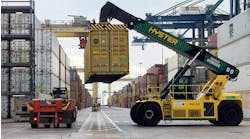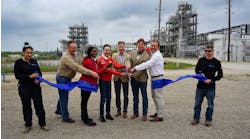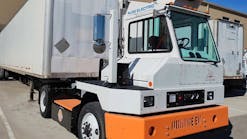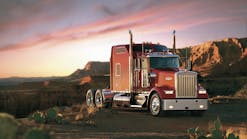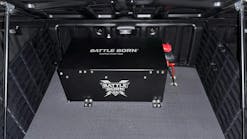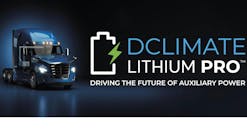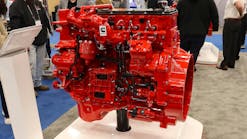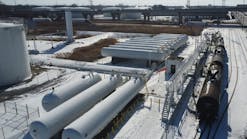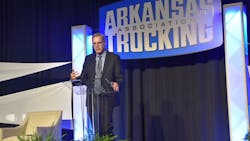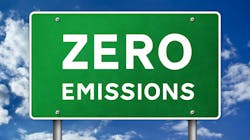LITTLE ROCK, Arkansas—While highway safety, nuclear verdicts, the workforce, and infrastructure all are critical matters for trucking, the “most front-burner” issues over the next decade will be energy and the environment, American Trucking Associations President and CEO Chris Spear emphasized here May 17.
“It's reached a boiling point,” Spear said in an address at the 2023 Arkansas Trucking Association Conference & Vendor Showcase. “In the next three to five years, with the proposals that we’ve seen by EPA, and mostly CARB, it will boil over—there's no question.”
Spear characterized the “irrational lunacy” of proposed emissions targets and rushed EV adoption timelines as “the mad dash to zero.”
The environmental lobby has become the most powerful policy influence in Washington, “unmatched by anyone,” he noted.
“Almost every piece of legislation that's relevant to our industry has an environmental hook to it,” Spear said. “The current majority in the Senate and the minority in the House and this administration are enamored with this narrative. They want to be as aggressive as they possibly can to get us to electric. And we're just saying, ‘not so fast.’”
Simply, Spear explained, the nation must have the charging infrastructure in place. A 40% increase in electricity has to come from somewhere, and the batteries have to be sourced.
“You've got lithium, cobalt, graphite, nickel—very key minerals, and 84% come from China,” he said. “In the current environment, both Republicans and Democrats are not going to want to source this from China. Where's your alternative? Congo. So we're going to have six year olds pulling that out of the dirt? Brilliant.”
And even though the U.S. does have important mineral deposits, the environmental lobby will block new mining permits.
“It's very illogical: They would have this industry, in my opinion, moving freight with donkey carts,” he said, then quipped, “if it weren't for the methane emissions.”
Price parity also will be a challenge, as fleets can’t foot the bill for electric trucks that cost three or four times today’s diesel vehicles, Spear pointed out.
Uncommon sense
Yet, a simple solution is already at hand. If policymakers would use their common sense, the transition to clean transportation will continue in a way that has delivered tangible results for decades, as Spear explained.
He pointed to trucking’s 40-year relationship with EPA, working “hand in glove” to develop solutions such as the SmartWay program to encourage voluntary adoption of more “environmentally friendly” equipment. Additionally, ATA has taken a “proactive” stance in the development of the first two phases of the greenhouse gas emissions regulations.
“We're now facing Phase 3 on NOx, which we all know is like squeezing blood out of a rock—this is the tough one,” Spear added. “But we’ve been there throughout the process, to ensure that the equipment that is ultimately put on the market is stringent and that those tractors can withstand the pressures that you put them through yet deliver those reductions that we seek for our environment.”
Indeed, thanks to trucking’s relationship with EPA, 98.5% of tailpipe pollutants have been removed over the decades, Spear touted—and trucking is committed to tackling that remaining 1.5%. But policymakers need to understand what the tremendous improvement really means and frame regulations accordingly.
“Sixty brand-new trucks today emit what one truck emitted in 1988—that, my friends, is a very good story,” Spear said. “That's innovation; that's this industry, collaborating with an agency, to create an outcome—one that is responsible, achievable. And that’s something we need to be much more vocal about. We are not anti-environment. This is a positive story.”
The recently launched Clean Freight Coalition, a joint effort by several trucking industry associations and equipment manufacturers, was formed to deliver that message—and make sure that the push for a decarbonized supply chain is guided by practical and achievable principles.
CARB’s looming Advanced Clean Trucks regulation is neither practical nor achievable, however. As Spear described it, “no one is going to be compliant” when the rule kicks in next year. And by 2035, more than half of the fleet is to be powered by alternative, non-carbon energy.
“It's not realistic,” Spear said. “It's not a matter of being opposed to zero emissions. We just need to be responsible, to have an achievable timeline and target. This is not it.”
Compounding the challenge, because EPA granted California a waiver to set its own emissions standards, CARB’s rule will, in effect, become the national standard and numerous states on both coasts will be following California’s lead.
“I don't think EPA is in a position to put forward the type of aggressive proposal that California has and is already prepared to do,” Spear said. “So what’s better than to just hand the keys over to California and let them do it? If it fails, it's California's fault. If it succeeds, we [the EPA] get credit for it, too.”
A different universe
Even if the charging infrastructure were in place, and even if the grid could provide the ATRI-estimated 40% more power needed to electrify cars and trucks, an all-electric supply chain cannot match today’s productivity, Spear continued.
“It takes 15 minutes to fuel a current tractor to go 1,200 miles,” Spear said. “The [electric] equipment we're talking about, if you could get your hands on it, requires two 16,000-lb batteries; that's 32,000 pounds that counts against your payload. You're going to reduce your payload, so you're going to have to add more trucks, more drivers—which we don't have—to offset that loss.
“And those two 16,000-lb batteries take six to 10 hours to charge, to go 300 miles. This isn't even in the realm of possibility. There's no parity—it's not even in the same universe. And people don't want to talk about this.”
ATA’s solution, as Spear recounted testimony before Congress, calls for a realistic transition—and one that will deliver impressive results immediately: Simply replace older trucks. According to Spear, 53% of trucks operating in California are model year 2010 or older. Updating that aging fleet with new equipment would reduce emissions in California by a whopping 83%.
“You could do that right now,” Spear emphasized. “Set aside electric and hydrogen—this is existing technology that over the next 10 years, with incentives, can have a dramatic impact on reducing emissions. Why isn't anyone wanting to talk about that? As a legislator, I'd be all over it. It's our responsibility as an industry to get louder on these points.”
To that end, Spear also called on Congress to repeal the Federal Excise Tax on new, more efficient heavy-duty highway equipment—a costly barrier to adoption. Current legislation stands “a good chance” due to trucking’s “common sense” explanation to lawmakers, Spear noted.
This story originally appeared on FleetOwner.com.
